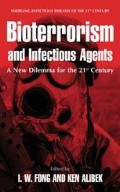9. Conclusion
Ricin is a potent and easy to extract plant toxin. Its characteristics make it a potentially dangerous biological weapon. We understand now, better than ever, the pathogenesis of ricin poisoning. But treatment of ricin poisoning is still mainly supportive. More research is needed to develop specific and effective modalities of treatment.
The threat of bioterrorism is no longer as remote as it was in the past. The medical community should be familiar with the clinical presentation and treatment of ricin poisoning. Knowledge will allow better recognition and response to an attack.
Preview
Unable to display preview. Download preview PDF.
References
Alibek, K. (1999). Biohazard. New York, Random House, Inc.
CDC. (2000). Biological and chemical terrorism: strategic plan for preparedness and response recommendations of the CDC Strategic Planning Workgroup. MMWR 49(RR-4):1–14.
Centers for Disease Control and Prevention. (2003). Laboratory testing for ricin in environmental samples—fact sheet. Available at: http://www.bt.cdc.gov/agent/ricin/labtesting.asp.
Challoner, K.R., and McCarron, M.M. (1990). Castor bean intoxication. Ann. Emerg. Med. 19:1177–1183.
Christopher, G.W., Cieslak, T.J., Palvin, J.A., and Eitzen, E.M. (1997). Biological warfare. A historical perspective. J.A.M.A. 278:412–417.
Crompton, R., and Gall, D. (1980). Georgi Markov—death in a pellet. Medico Legal J. 48(2):51–62.
Eitzen, E.M., and Takafuji, E.T. (1997). Historical overview of biological warfare. In: Sidell, F.R., Takafuji, E.T., and Franz, D.R. (eds.), Textbook of Military Medicine: Medical Aspects of Chemical and Biological Warfare. TMM Publications, Washington, D.C.
Ellenhorn, M.J. (1997). Plants — mycotoxins — mushrooms. In: Ellenhorn’s Medical Toxicology: Diagnosis and Treatment of Human Poisoning. Baltimore, Williams & Wilkins, pp. 1847–1849.
Fodstad, O., Kvalheim, G., Godal, A., Lotsberg, J., Aamdal, S., Host, H., and Pihl, A. (1984). Phase I study of plant protein ricin. Cancer Res. 44:862–865.
Franz, D.R., and Jaax, N.K. (1997). Ricin toxin. In: Sidell, F.R., Takafuji, E.T., and Franz, D.R. (eds.), Textbook of Military Medicine: Medical Aspects of Chemical and Biological Warfare. TMM Publications, Washington, D.C.
Frigerio, L., and Roberts, L.M. (1998). The enemy within: ricin and plant cells. J. Exp. Botany 49(326):1473–1480.
Hampton, T. (2004). Ricin vaccine developed. JAMA 292:1419-a.
Hostetler, M.A. (2003). Toxicity, plants — castor bean and jequirity bean. Available at: http://www.emedicine.com/ped/topic331.htm.
Kaku, H. (1998). Ricin related protein family. Available at: http://www.glycoforum.gr.jp/science/word/lectin/LEA08E.html.
Kende, M., Yan, C., Hewetson, J., Frick, M.A., Rill, W.L., and Tammariello, R. (2002). Oral immunization of mice with ricin toxoid vaccine encapsulated in polymeric microspheres against aerosol challenge. Vaccine 20(11–12):1681–1691.
Koppel, A., MacVicar, S., Schuster, H., and Moniquet, C. (2003). Deadly ricin at Paris rail station. Available at: http://www.cnn.com/2003/WORLD/europe/03/20/france.ricin/index.html.
Kortepeter, M.G., Christopher, G., Cieslak, T., Culpepper, R., Darling, R., Palvin, J., Rowe, J., McKee, K., and Eitzen, E. (2001). USAMRIID’s Medical Management of Biological Casualties Handbook, 4th ed. U.S. Army Medical Research Institute of Infectious Diseases, Fort Detrick, Frederick, MD, pp. 130–137.
Kortepeter, M.G., and Parker, G.W. (1999). Potential biological weapons threats. Emerg. Infect. Dis. 5:523–527.
Kreitman, R.J. (1999). Immunotoxins in cancer therapy. Curr. Opin. Immunol. 11:570–578.
Kreitman, R.J. (2001). Toxin-labeled monoclonal antibodies. Curr. Pharm. Biotechnol. 2:313–325.
Lord, J.M., Roberts, L.M., and Robertus J.D. (1994). Ricin: structure, mode of action, and some current applications. FASEB J. 8:201–208.
Maman, M., Sagi, R., Moseri, R., and Yehezkelli, Y. (2003). Ricin—a potent plant toxin. In: Shoenfeld, Y., and Shemer, J. (eds.), Terror and Medicine. Pabst Science Publishers, Berlin.
Mayor, S. (2003). UK doctors warned after a ricin poison was found in police raid. Br. Med. J. 326:126.
Mirarchi, F.L., and Allswede, M. (2003). CBRNE — ricin. Available at: http://www.emedicine.com/emerg/topic889.htm.
Oeltmann, T.N., and Frankel, A.E. (1991). Advances in immunotoxins. FASEB J. 5(10):2334–2337.
Old Testament. (1982). Jonah 4:6–9. Copyright by Y. Orestein, “Yavne” Publishing House, Ltd., Tel-Aviv.
Olsnes, S., and Kozlov, J.V. (2001). Ricin. Toxicon 39:1723–1728.
Olsnes, S., and Pihl, A. (1976). Abrin, ricin and their associated agglutinins. In Cuatrecasas, P. (eds.), Receptors and Recognition. Series B. The Specificity and Action of Animal, Bacterial and Plant Toxins. Chapman and Hall, London, pp. 129–173.
Rauber, A., and Heard, J. (1985). Castor bean toxicity re-examined: a new prospective. Vet. Hum. Toxicol. 27:498–502.
Sandvig, K., and Van Deurs, B. (2000). Entry of ricin and Shiga toxin into cells: molecular mechanisms and medical perspectives. EMBO J. 19:5943–5950.
Sandvig, K., and Van Deurs, B. (2002). Transport of protein toxins into cells: pathways used by ricin, cholera toxin and shiga toxin. FEBS Lett. 529(1):49–53.
Shyu, H.F., Chaio, D.J., Liu, H.W., and Tang, S.S. (2002). Monoclonal antibody-based enzyme immunoassay for detection ricin. Hybrid Hybridomics 21:69–73.
Smallshaw, J.E., Firan, A., Fulmer, J.R., Ruback, S.L, Ghetie, V., and Vitetta, E.S. (2002). A novel recombinant vaccine which protects mice against ricin intoxication. Vaccine 20:3422–3427.
Wedin, G.P., Neal, J.S., Everson, G.W., and Krenzelok, E.P. (1986). Castor bean poisoning. Am. J. Emerg. Med. 4(3):259–261.
Weissmann-Brenner, A., Brenner, B., Kats, L., and Hourvitz, A. (2002). Ricin — from a Bulgarian umbrella to an optional treatment of cancer. Harefuah 141:153–156. [Hebrew].
Yan, C., Rill, W.L., Malli, R., Hewetson, J., Naseem, H., Tammariello, R., and Kende, M. (1996). Intranasal stimulation of long lasting immunity against aerosol ricin challenge with ricin toxoid vaccine encapsulated in polymer microspheres. Vaccine 14:1031–1038.
Zilinskas, R.A. (1997). Iraq’s biological weapons: the past as future? J.A.M.A. 278:418–424.
Author information
Authors and Affiliations
Editor information
Editors and Affiliations
Rights and permissions
Copyright information
© 2005 Springer Science+Business Media, Inc.
About this chapter
Cite this chapter
Maman, M., Yehezkelli, Y. (2005). Ricin: A Possible, Noninfectious Biological Weapon. In: Fong, I.W., Alibek, K. (eds) Bioterrorism and Infectious Agents: A New Dilemma for the 21st Century. Emerging Infectious Diseases of the 21st Century. Springer, Boston, MA. https://doi.org/10.1007/0-387-23685-6_8
Download citation
DOI: https://doi.org/10.1007/0-387-23685-6_8
Publisher Name: Springer, Boston, MA
Print ISBN: 978-0-387-23684-1
Online ISBN: 978-0-387-23685-8
eBook Packages: MedicineMedicine (R0)

